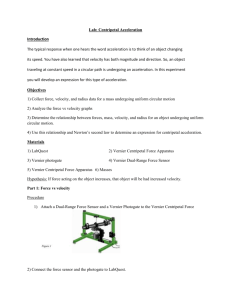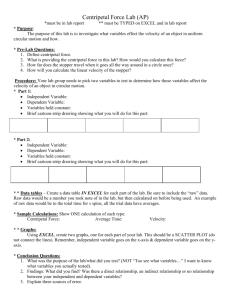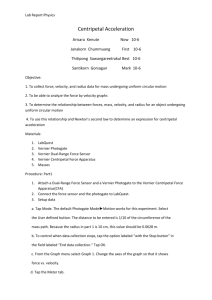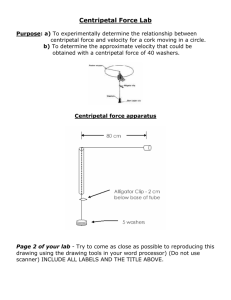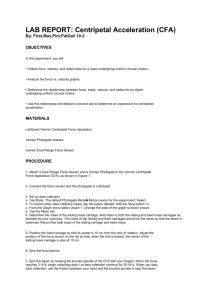Lab physic - WordPress.com
advertisement
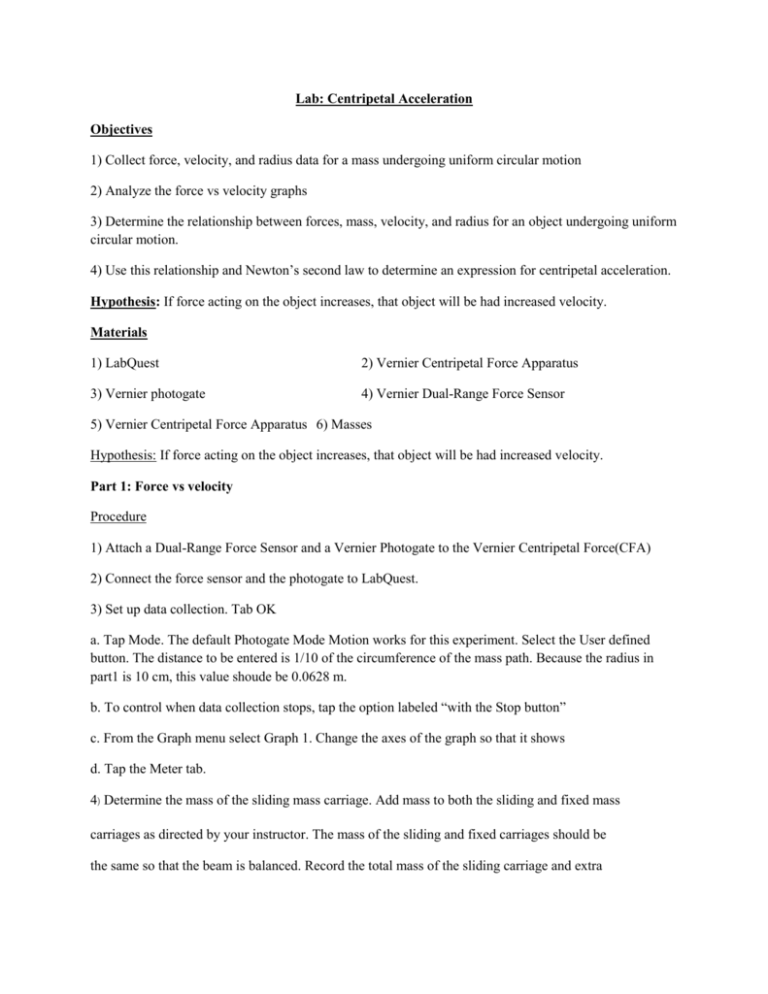
Lab: Centripetal Acceleration Objectives 1) Collect force, velocity, and radius data for a mass undergoing uniform circular motion 2) Analyze the force vs velocity graphs 3) Determine the relationship between forces, mass, velocity, and radius for an object undergoing uniform circular motion. 4) Use this relationship and Newton’s second law to determine an expression for centripetal acceleration. Hypothesis: If force acting on the object increases, that object will be had increased velocity. Materials 1) LabQuest 2) Vernier Centripetal Force Apparatus 3) Vernier photogate 4) Vernier Dual-Range Force Sensor 5) Vernier Centripetal Force Apparatus 6) Masses Hypothesis: If force acting on the object increases, that object will be had increased velocity. Part 1: Force vs velocity Procedure 1) Attach a Dual-Range Force Sensor and a Vernier Photogate to the Vernier Centripetal Force(CFA) 2) Connect the force sensor and the photogate to LabQuest. 3) Set up data collection. Tab OK a. Tap Mode. The default Photogate Mode Motion works for this experiment. Select the User defined button. The distance to be entered is 1/10 of the circumference of the mass path. Because the radius in part1 is 10 cm, this value shoude be 0.0628 m. b. To control when data collection stops, tap the option labeled “with the Stop button” c. From the Graph menu select Graph 1. Change the axes of the graph so that it shows d. Tap the Meter tab. 4) Determine the mass of the sliding mass carriage. Add mass to both the sliding and fixed mass carriages as directed by your instructor. The mass of the sliding and fixed carriages should be the same so that the beam is balanced. Record the total mass of the sliding carriage and extra 5) Position the fixed carriage so that its center is 10 cm from the axis of rotation. Adjust the position of the force sensor on the rail so that, when the line is tensed, the center of the sliding mass carriage is also at 10 cm. 6) Zero the force sensor. 7) Spin the beam by twisting the knurled spindle of the CFA with your fingers. When the force reaches 3–4 N, begin collecting data. Let data collection continue for 20‑40 s. When you stop data collection, use the friction between your hand and the knurled spindle to stop the beam. 8) If your graph of force vs. velocity is not linear, create a “calculated column” that will enable you to obtain a linear graph (linearized graph F vs. v2) step how to do this if you cannot do it by yourself. Results It was found that when the object is moving in a circle by same angle, the object’s velocity will be increase associated with force of excitation. This can best be understood by looking at 2nd of Newton's Laws of Motion. For figure 1, we force exerted on an object increases, make objects have acceleration increases. According with the Newton’s law; if we push the two objects exert equal and unequal mass. The objects with more mass moving at velocity less than an object with less mass. Figure 1: Relationship between with force and velocity Conclusion From that experiment, the experiment may have an error from the human or instrument error of this trial. So that before started the experiment, we recommended, should be calibrate to the instrument. Furthermore, the experiment should be repeated. The results of this experiment May be applied in the study of engineering, such as vehicle design to be able to raise the curve faster or satellite dishes designed to be used in different ways even more. With concluding from that experiment, when force exerted on an object increases, make objects have acceleration increases. And, if we push the two objects exert equal and unequal mass. The objects with more mass moving at velocity less than an object with less mass. Extra Point Wikipedia warns that the centripetal force is not to be confused with centrifugal force. It describes the latter as a fictitious or inertial force. Describe an example of such a force that you have experienced and how this interaction might better be explained in terms of centripetal force (do not use the example given in class). A centrifuge is a piece of equipment, generally driven by an electric motor (or, in some older models, by hand), that puts an object in rotation around a fixed axis, applying a force perpendicular to the axis. A centrifuge is also used to separate the components of blood in blood banks. The centrifuge works using the sedimentation principle, where the centripetal accelerationcauses denser substances to separate out along the radial direction (the bottom of the tube). By the same token lighter objects will tend to move to the top (of the tube; in the rotating picture, move to the centre). Like all other centrifuges, laboratory centrifuges work by the sedimentation principle, where the centripetal accelerationis used to separate substances of greater and lesser density.
